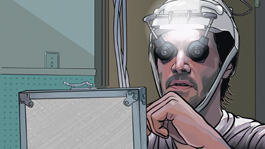home | metro silicon valley index | movies | current reviews | film review

The NSA Has Gone Too Far: Keanu Reeves thinks his every key stroke is monitored in 'A Scanner Darkly.'
Arctor Warming
Keanu Reeves spies on himself in Philip K. Dick's salute to paranoia, 'A Scanner Darkly'
By Richard von Busack
ONE WAY of looking at Philip K. Dick is as a proto-martyr of speed. Meth and pharmaceutical amphetamines flavored the novelist's conception of the treacherous 20th century. The cop-ridden 1970s Orange County in which Dick lived is fancifully re-created in Richard Linklater's computer-animated adaptation of A Scanner Darkly, even if the story is time-shifted to Anaheim in 2013.
The plot depends on a simple gimmick. A narcotics officer known as Fred, whose identity is concealed even from his superiors, is assigned to spy on himself. As Bob Arctor (Keanu Reeves), the narc has a connection for the disorienting drug called "Death," or "Substance D."
San Francisco.com Real Estate
Moving to the Bay Area just became easy. Let San Francisco.com show you all the homes currently for sale.
San Jose.com Real Estate
Relocating to San Jose or Silicon Valley? Let San Jose.com introduce you to some expert area real estate agents.
But who came first, Arctor or Agent Fred? One clue isn't conclusive, although the anecdote about how Arctor dropped out of family life is as pungent as the tale of how Mr. Flitcraft left his wife for good in The Maltese Falcon.
And the questions of identity are worthy of the mysterious passage in 2 Corinthians 3:11 that Dick borrowed for the title of his 1977 novel. Yet this shimmering computer-animated film takes place on a less lofty level.
Arctor's house is a battered shame-of-the-suburbs "dungalow" stuck in a literal and temporal cul-de-sac. Inside, Arctor's loafing housemates, Ernie (Woody Harrelson) and James (Robert Downey Jr.), are trying to blur out those dreaded moments of clarity. When the two fools squabble over a used bicycle, the film gets lifted with the rhythms of an invigorating sitcom. A buddy drops by: Charles Freck (Rory Cochrane), half-crazy from being nipped by imaginary weevils. "I looked 'em up; they're aphids," says crafty James, encouraging Freck to bring the critters by in a glass jar for inspection.
Arctor has a girlfriend, sort of—Donna, a nervous, touch-me-not coke dealer played by Winona Ryder. The complexity of their friendship worsens when Fred/Bob's masked superior officer tells him that she is the ringleader of a drug network.
Reeves is hardly underrated as an actor—he's rated about right—still, he is perfect playing an anti-man, exhausted of emotion. And his crumbling voice is right for Arctor/Fred, whose literal duplicity worsens as Substance D burns out the connecting tissue between the hemispheres of his brain.
The realistic animation technique is called "interpolated rotoscoping." Oddly, Linklater almost never uses it for fantastic imagery, except in the scenes of the police "scramble suits" used to mask identities. These are jumpsuits upon which myriad faces and physiques are projected.
The effort of realistically animating the human characters is rich with possibilities for both surreal and hyperreal stories. We see a half-hidden joke—a note saying "Time to thaw Walt out"—posted on the refrigerator over a caricature of a frozen, cross-eyed head. Linklater's use of computer animation comes across as far more intellectually exciting than the kid-narcotizing animated features we get every fortnight—all those glacial brainchildren of Disney's frozen head.
Linklater used this rotoscoping for the pleasures of enlightenment in Waking Life. Now, he shows the other side of it: he has gone from a vision of total liberation to the kind of paranoia that leads to mindlessness and slavery. Moreover, drug abusers often feel like characters in cartoons, detached from reality and its consequences. But just as it is difficult to make a truly antiwar film, it is also tough to make a completely anti-drug film. Directors fret over the "glamorization" of the experience. As in David Cronenberg's Naked Lunch, Linklater takes the pleasure out of drugs and leaves the hangovers.
These horror-comedy moments show most clearly in the story of the household's car breaking down during a road trip. Stranded, Bob, Ernie and James construct a castle of paranoia. Someone severed the car's brake line. Ah, it was the cops, and they will surely search the house despite an elaborate psych-out trap that James created to fool them. But what if the cops get enraged and stomp their pet house cats?—and so forth. By underscoring the era's terror of snitches and agents provocateurs, Linklater, like Dick, shows that it was more than bad chemicals that destroyed so many lives.
The film ends with a roster of the people Dick knew whom drugs, especially speed, destroyed. They can call it "Substance D," but the scramble-suit that meth is wearing in A Scanner Darkly hardly conceals the drug's identity. While mourning for them, Dick gave the dead credit for their bravery as experimenters who tried to break that dark glass that kept them from seeing the world as it was. Dick sentimentally called his dead friends "comrades." Those who have experienced the intensity of drug-induced friendships, those who remember that companionship and compassion, might say that that war-memorial word is deserved.
But in the end, the drug experience is almost secondary. A Scanner Darkly has zeitgeist by the bushel. Its evocation of Dick's speed-crash paranoia harmonizes with our own paranoid age. They say that those who have nothing to hide need not worry, but who really has nothing to hide?
![]() A Scanner Darkly (R; 100 min.), directed by Richard Linklater, written by Linklater, photographed by Shane F. Kelly and starring Keanu Reeves and Winona Ryder, opens July 14.
A Scanner Darkly (R; 100 min.), directed by Richard Linklater, written by Linklater, photographed by Shane F. Kelly and starring Keanu Reeves and Winona Ryder, opens July 14.
Send a letter to the editor about this story.
|
|
|
|
|
|
